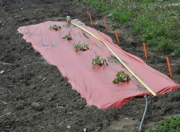 Plastic mulches have long been known to provide advantages for the vegetable grower including earlier fruiting, increased yields and weed control. More recently advantages have been noted for colored mulches over the more traditional black plastic mulch. With tomatoes, the color of choice has been red. Though normally there is an increase in production of marketable fruit with red mulch over black mulch, the amount of the increase varies with the type of year we have. There may be no increase during years of near-perfect weather or up to a 20% increase with less favorable growing conditions. A good average expected increase is about 12%. So, how do you apply plastic mulch? Commercial growers have a mulch-laying machine that applies the trickle irrigation line and the mulch in one operation. Home gardeners must do this by hand. The first step after soil preparation is to place a trickle line near the center of where the mulch will lay as the plastic will prevent rainwater or overhead irrigation from reaching the plants. Then construct trenches for the outer 6 inches of the plastic mulch. This allows the center of the bed to be undisturbed with the edges of the mulch draping down into the trench. Fill the trenches to cover the edges of the mulch. This will prevent wind from catching and blowing the mulch. If the soil has been tilled, a hoe is all that is needed to prepare the trenches. (Ward Upham) 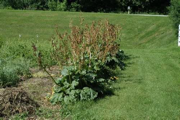 Rhubarb, like asparagus, is a perennial vegetable. It is harvested for the leaf stem, which is also called a petiole. Some years rhubarb will produce large, hollow-stemmed seedstalks that arise from the center of the plant. These should be broken or cut out as they appear so that energy will go into plant vigor rather than seed production. It will take several weeks for all the seedstalks to appear so be vigilant in removing them. Newer varieties of rhubarb are selected for vigor, bright red-colored stalks and less of a tendency to produce seedstalks than the older types. (Ward Upham) It used to be simple to decide which sweet corn to plant. You simply chose a cultivar and planted when the soil temperature reached 55 degrees. Now it has become more complicated due to genetic advances in sweet corn. Breeders have found certain genes that improve “standard” sweet corn. Below is an overview of the types commonly available to homeowners.
Standard (su): This is our “normal” sweet corn and contains a “sugary gene” (su). Standard sweet corn should be isolated from field corn, popcorn, supersweets and ornamental corn. To isolate one type of corn from another, do not plant one type within 200 to 250 feet or be sure to have a difference of 12 to14 days in time to maturity. Plant when the soil temperature reaches at least 55 degrees. Recommended varieties include Honey and Cream, Silver Queen, Sterling Silver, Jubilee, or Merit. Supersweet (sh2): Though supersweets have up to three times the sweetness of standard sweet corns and hold their sweetness longer after harvest due to the sh2 gene, they do have some drawbacks such as tougher kernels and a lack of some of that good “corn” flavor. They also need to be isolated from other sweet corn types and are very sensitive to cooler soils. Wait until the soil temperature reaches 65 degrees before planting. Try Candy Store, Florida Staysweet, Sugar Loaf, Sweet Time, or Sweetie. Sugar Enhanced (se): These are probably the most popular type of sweet corn grown due to their tender kernels, good flavor and less sensitivity to cool soils (60 degree soil temperature for planting). They hold their post-harvest sweetness longer than standard types but will not hold sweetness as long as the supersweets. The sweetness from the sugar-enhanced types is due to the “se gene.” If both parents were se types, the variety is known as a se+ or se se. If only one parent was a se type and the other a su type, then the variety will be listed as se. They do not need to be isolated other than from the supersweets. Suggested varieties include Bodacious, Ambrosia, Sweet Temptation, Delectable and Miracle. Triplesweet (synergistic): The newest types of sweet corns blend the su, se and supersweet types with the goal of combining the best characteristics of each. We don’t have firm recommendations yet but you may want to try Serendipity, Polka, Avalon or Frisky. (Ward Upham) 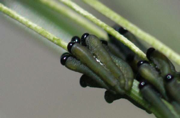 European pine sawfly, Neodiprion sertifer larvae were detected feeding on my “indicator pine” in Manhattan, KS (I was totally excited!) on April 17. Young caterpillar- looking larvae are 1/4 inch in length and olive-green in color with a black head. Mature larvae are >1.0 inch long with green stripes. The larvae are gregarious or feed in groups on needles of a variety of pines, especially Scotch, red, and mugo pine. When disturbed, each individual larva will arch their head and abdomen (last segment of an insect body) back, forming a “C-shape,” which is a defensive posture to ward-off predators. Eventually, larvae will strip the needles of mature foliage, leaving only the central core, which is white and then turns brown. In general, larvae complete feeding by the time needles emerge from the candelabra. Therefore, those needles are not damaged. There really is only a minor threat of branch or tree death resulting from sawfly larval feeding. However, the loss of second- and third- year needles will be noticeable in landscape trees; thus ruining their aesthetic appearance. In late spring, larvae drop to the ground and pupate in brown, leathery cocoons located at the base of trees. Adults, which are wasp-like, emerge in fall and lay eggs in needles prior to the onset of winter. There is one generation per year in Kansas. Sawfly larvae look like caterpillars but they are not caterpillars (Order: Lepidoptera). Sawflies are related to ants, bees, and wasps (Order: Hymenoptera). The primary way to distinguish a sawfly larva from a caterpillar is by the following: 1) sawfly larva have prolegs (fleshy abdominal legs) on every abdominal segment whereas caterpillars are missing prolegs on the abdomen and 2) caterpillar larva have hairs or crochets on their feet whereas sawfly larva do not have hairs or crochets on their feet. Sawfly larvae are not caterpillars, therefore, the bacterial insecticide, Bacillus thuringiensis subsp. kurstaki (sold as Dipel) will not directly kill sawfly larvae. Dealing with sawfly larvae involves hand-picking (you can wear gloves if you wish) or dislodging larvae from plants by means of a forceful water spray. If necessary, there are a number of insecticides that may be applied to suppress European pine sawfly populations including: acephate (Orthene), azadirachtin, carbaryl (Sevin), spinosad (Captain Jack’s DeadBug Brew and Conserve), and any pyrethroid insecticide (e.g., bifenthrin, cyfluthrin, and lambda-cyhalothrin). Be sure to read the insecticide label to make sure that sawflies are listed. For more information regarding European pine sawfly management contact your county or state extension specialist. (Raymond Cloyd) Both termites and ants are able to swarm and may have wings during part of their lives. Since these insects are close to the same size, people often misidentify flying ants as termites. Since flying ants do not attack wooden structures like
termites, it is helpful to be able to tell the difference. Fortunately, there are several differences that can easily distinguish the two. For example, ants have a thin waist; the waist of a termite is thick. Also, ants' antennae are elbowed, while termites' are not. Thirdly, termites have two pairs of wings that are of equal length. Ants also have two pairs of wings, but theirs are of unequal length. Homeowners who find signs of termite activity should shop for a reputable pest control firm. (Ward Upham) 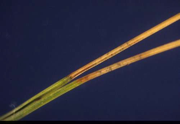 If you are having problems with the needles on pines turning yellow, check for Dothistroma Needle Blight (Mycosphaerella pini) as it has been very common this spring. Scots pine is considered resistant. This fungal disease causes the tips of needles to turn yellow, and yellow to tan bands to form along the needle. The black fruiting bodies have erupted through the surface of the needle. Needle blight is most serious on Austrian and Ponderosa pines and also can affect Mugo pines. Winter desiccation can cause these same needle-yellowing symptoms, including banding, but does not exhibit the black fruiting bodies. This also is very common this year likely due to the extreme cold we had on December 18. Though less common this spring, there can be other causes of yellowing needles. Brown spot (Scirrhia acicula) looks much like Dothistroma but affects primarily Scots pine. Ponderosa pine also is susceptible to brown spot, but Austrian pine is resistant. Tip blight, another disease, can affect Austrian, Ponderosa, Scots, and Mugo pines, but Austrians are most susceptible. This disease normally kills tips of branches when the needles are about half grown in the spring. This disease results in the death of the entire needle, not just the tips. If the tips of branches are dead and the needles on these branches are shorter than normal, suspect this disease. Some copper-containing fungicides can be used for control of Dothistroma needle blight. A single fungicide application in early June normally will protect foliage from infection. There is some risk in a single application because susceptible older needles are not protected in late May. Two fungicide applications in mid-May and mid- to late-June provide a more complete and dependable control. Make sure all needles are thoroughly covered with the fungicide. It is a good idea to spray adjacent susceptible pines. It may take multiple years of application to bring the disease under control. Copper fungicides are suggested for control such as Junction, Kocide, Camelot, Bonide Liquid Copper Concentrate, and Monterey Liqui-Cop. Collection and removal of diseased needles on the ground around individual trees may reduce the severity of infection the following year. Nevertheless, sanitation probably will not eliminate the disease because diseased needles bearing fruiting structures of the fungus sometimes remain attached to the tree. Removal of dead needles is impractical in windbreak plantings. If you are unsure which problem you have, now would be a good time to take a sample to your local K-State Research and Extension office so they can send it to the K-State Plant Pathology Lab for positive identification. (Ward Upham) 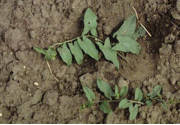 Field bindweed is difficult to control, especially for homeowners, but there are options. Home Vegetable Gardens: Weed control requires taking the treated portion of the garden out of production for a time. Glyphosate - Glyphosate is sold under a wide variety of names, the most common being Roundup. Take the garden out of production when treating. 1. Glyphosate is a non-selective herbicide that will kill whatever it hits but is inactivated when it contacts the soil. 2. Glyphosate is most effective when applied to bindweed that is at or beyond full bloom. You can treat earlier but don't skip the late summer to fall application. 3. Do not apply to bindweed that is under moisture stress or not growing well. The better the bindweed is growth, the more herbicide is taken up and the better the kill. Turf: Selective herbicides are available. A herbicide with the active ingredient of quinclorac is now packaged in homeowner combination herbicides such as Fertilome Weed-Out with Q, Ortho Weed-B-Gon Max + Crabgrass Control, Monterey Crab-E-Rad Plus and Bayer All-in-One Lawn Weed and Crabgrass Killer. Commercial applicator products include Drive, Eject, Facet and Paramount, all of which contain quinclorac. Combination products containing quinclorac include Q4, Quincept and Quinstar. Products with quinclorac work better than glyphosate and are selective. Note that lawns treated with quinclorac should not use clippings in compost or as mulch as quinclorac is very stable on grass clippings. We recommend clippings be returned to the lawn anyway but if they are bagged, they should be discarded. Do not apply products with quinclorac over exposed roots of trees and ornamentals. It would be best to avoid spraying beneath the canopy of any trees to avoid possible damage. If there are plans to convert a section of lawn to a vegetable garden, do not use quinclorac on that area. Eggplants can be damaged if planted within 12 months of areas treated with quinclorac, and tomatoes can be damaged if planted within 24 months. Shrub Beds: Use a spray of glyphosate between plants. Use a shield if spraying near plants to keep spray from contacting green plant material. Remember, glyphosate will hurt your shrubs if it contacts green tissue. It is possible to control field bindweed by pulling, but you must be extremely persistent. I remember reading a study from the 1940s that found that bindweed produces enough energy to start strengthening the roots when it reached the six-leaf stage. So, if pulling, never allow plants to produce more than six leaves. (Ward Upham) Most people enjoy the wide variety of wildlife found in Kansas until that wildlife becomes a nuisance or damages property. Charlie Lee, K-State Wildlife Management Specialist, has put together a web site on wildlife management at http://www.wildlife.k-state.edu/ . Species covered include everything from bats to woodrats. Each species page also incorporates quick links for more in- depth information. One of our most common pest species, moles, includes videos on tracking an active tunnel and setting a mole trap. This site is an excellent resource for the various options of dealing with our interactions with wildlife in a safe and effective manner. (Ward Upham)
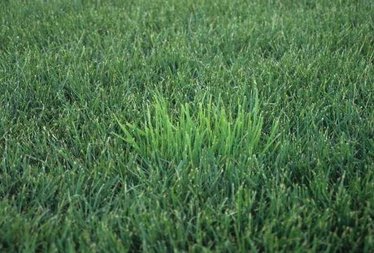 Orchardgrass often infests tall fescue lawns. Unfortunately, orchardgrass is lighter green and faster growing than tall fescue, so it is very visible. Homeowners complain of the light green tufts of grass wherever this weed has become established. Even worse, there are no herbicides that will kill the orchard grass without also killing the turf. About the only good thing about orchardgrass is that it is a bunch grass and does not spread. Orchardgrass often comes in as a contaminant in grass seed, especially K-31 tall fescue. Buying good grass seed is the first line of defense against this weed. Orchardgrass is a pasture grass and therefore is not found in the “weed seed” portion of the seed label. Rather, orchard- grass will be listed as “other crop seed.” Try to buy grass seed that has 0.0% “other crop seed.” Control options are few and painful. Use glyphosate (Roundup, Killzall Weed and Grass Killer, Kleeraway Systemic Weed and Grass Killer and others) to spot spray orchardgrass clumps. Any lawn grasses you hit will be killed, so keep the spots sprayed as small as possible. Wait until the spots have turned brown and then cut out the clumps and replace with a small piece of sod. Large numbers of orchardgrass clumps may mean it is more practical to kill the entire lawn and start over. This should be done in the fall rather than now. For information on identification of orchardgrass, including images, go to: http://kswildflower.org/grass_details.php?grassID=15 (Ward Upham) |
AuthorsCynthia Domenghini runs the Horticulture Response Center in the Department of Horticulture and Natural Resources at Kansas State University. Other contributors include K-State Extension Specialists. Archives
March 2024
Categories
All
|
| K-State Research and Extension Horticulture Newsletter |
|
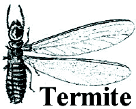
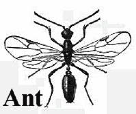
 RSS Feed
RSS Feed
